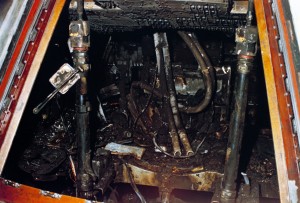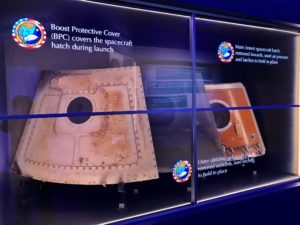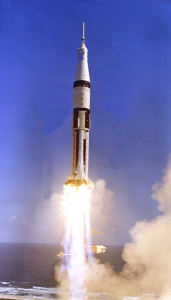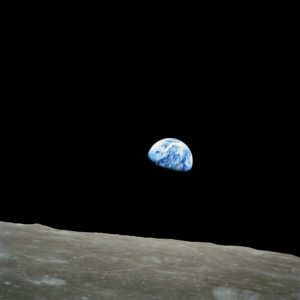January 27th, 1968 marked one year since the fire at Launch Complex 34 that killed the crew of Apollo 1: Gus Grissom, Ed White, and Roger Chaffee. One year without a manned American space flight. One year of major change to our space program. One year of relative uncertainty.
1968 would, as fate would have it, be a hell of a year for the nation on a whole – political turmoil and assassinations along with civil unrest over Vietnam and Civil Rights, the nation was changing. In somewhat of a reversal for how the nation was socio-politically, 1968 would prove to be an amazing year for the United States in its return to space.
That all took time, though – through the rest of 1967 and early 1968 NASA and the various companies and groups that were making Apollo happen had to figure out just what went wrong, and fix it. Not only that, they had to make things better than they were – the nation lost valuable time due to the fire, and we had to play catch up.

A commission was set up to investigate the fire. The Apollo 1 spacecraft was taken apart with every single object documented… including a socket wrench simply left inside the vehicle during assembly. Another Apollo Command Module, identical to Apollo 1 in construction, was also disassembled for comparison.
It was found that the Apollo 1 spacecraft was severely flawed on many points, and that the pure oxygen environment used, which was considered safe in space, was extremely dangerous while still on Earth – the test itself should have been considered dangerous in its own right, but no one determined there would be a risk in conducting these types of tests, which by then were actually quite common.
The hatch design was poor and not suited for rapid egress from the Apollo Command Module. The hatch would be re-designed to open much more quickly, and the atmosphere inside the Apollo spacecraft would be changed to a mixed nitrogen-oxygen environment. Flammable materials in the vehicle would be kept to a minimum, including a change to the astronauts suit materials.
Beyond Apollo 1 itself, everything about the program was a bit of a mess – improper documentation and procedures, support equipment that just wasn’t ready, the list goes on and on. Apollo in 1967 really wasn’t ready, and the fire was the worst way for us to realize that.

The Apollo 1 hatch.
The Block 1 Apollo Spacecraft that remained would be used in unmanned test flight – Apollo 4 and Apollo 6 in particular – with all future manned flights to use the revised Block 2 Apollo CSM’s. Block 2 vehicles were already planned to be the actual craft to make flights to the Moon, having been designed to dock with the Lunar Module (something the block one modules were incapable of) among other modifications. They were revised to include all the safety recommendations made after the Apollo 1 fire.
Interestingly, it seems nearly everyone involved in the space program, be it NASA themselves, or the companies producing hardware for the missions, took the blame for the fire. They all felt it was their own fault in one way or another: Gene Kranz gave a now legendary speech to his mission control crew regarding the attitude that was present at the time – a phenomena that would be known as “go fever,” no one stopping to think something should be thought about more in depth, that something should be stopped, or a risk considered. We couldn’t slow down. We wouldn’t slow down, and that cost lives.
NASA would continue preparing for the goal of landing a man on the Moon. Apollo 4, the first Saturn V flight, would launch in November 1967. In January 1968, the Saturn 1B originally built to launch Apollo 1 would fly, carrying the first Lunar Module on its own successful test flight. Multiple lunar probing missions would be launched with varying levels of success, but with each flight we learned more about the Moon, as well as Mars,
One year after the fire, things were looking better for the United States and manned spaceflight. Another Saturn V test was scheduled, and a manned test flight of the revised Block 2 Apollo CSM was planned for late 1968. Later still would come a change to the then planned mission schedule which would result in what may have been the riskiest mission in all of the Apollo program.

The launch of Apollo 7, which flew the mission intended for Apollo 1.
It’s strange in retrospect. As horrible as it was, the Apollo 1 fire might well have been the best thing to happen to Apollo. It caused everyone involved to redouble their efforts, fix what was wrong, consider things they would have overlooked and with success after success in later missions we were able to accomplish the manned Lunar landing goal in 5 flights.

Back on January 27th, 1968 though, well, we still were wondering if we could do this. The wound of Apollo 1 was still fresh, but we would recover.
Sadly, history would repeat itself in slightly different ways, but with the same end results in 1986 and 2003.
https://en.wikipedia.org/wiki/Apollo_1
https://en.wikipedia.org/wiki/Apollo_Command/Service_Module
